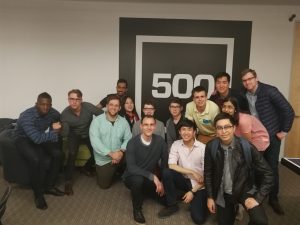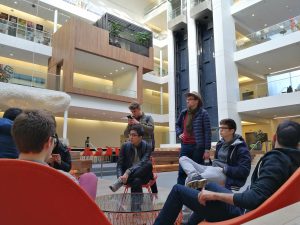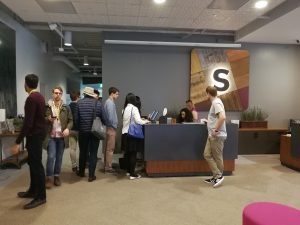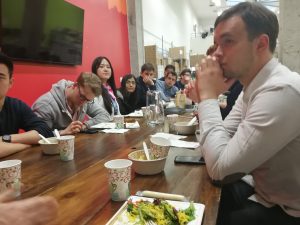This is the third instalment in my Silicon Valley saga. In case you missed them, here are the first and second posts.

The messaging app was bought by Facebook in 2014 and recently moved into the Facebook campus, which has the nerdtastic address of 1 Hacker Way. It was interesting to compare this campus with Google’s. It felt more like a theme park rather than a university. I was surprised how corporate it felt despite the casual clothes, fancy screens and wonderfully designed posters. Maybe I’ve just watched too much dystopian sci-fi but whenever a place is too perfect I feel it could make for a good Dr Who episode. It did have an incredible, and completely free, ice cream parlour though. I would get so fat working in Silicon Valley.
WhatsApp is in an interesting position of being part of a colossal, multi-billion dollar company but still being a small, mostly separate tech company. They can call on the expertise and huge resources of the mother company but the employees don’t get lost inside the machine. They face some niche engineering challenges, such as stopping spam whilst not being able to process message contents as they’re encrypted. Probably the best insight I gleaned there was the observation that internal company communication is an n2 problem. Thus as a company grows it becomes exponentially important to communicate and coordinate well. No wonder behemoths become bureaucratic nightmares.
I don’t think the WhatsApp people were quite ready for a room full of Oxford students. They wanted to give a standard recruitment pitch and are probably used to students begging for a job and playing nice. Instead they got difficult penetrating questions of how to monetise WhatsApp, how they’re positioning themselves against Snapchat and the nature of coordination and integration with Facebook. Poor people, they thought free ice cream and details of their job positions would satisfy us.
AirBnB
This was one of the best visits, not in small part to our alumnus guide, Derek. AirBnB’s offices in downtown San Fran are in a converted industrial building with the old tram tracks still running through the floor. It really is a beautiful designer’s paragon, reflecting the design focus of the founders and the company itself. Their meeting rooms are recreations of actual AirBnB listings.
What seemed to separate AirBnB from the other companies we visited was this focus on design and really pushing the brand and culture. Their mission is to make everyone feel at home everywhere (something that as a consultant with wanderlust I really appreciate) but to convince people to stay with a complete stranger and home-owners to welcome in randoms they need to create a safe, comfortable and friendly vibe. They are also one of the few SV companies that actually is trying to get people away from screens and into the ‘real’ world. This created a much gentler atmosphere than the other ‘disrupters’. It’s one which Facebook which is supposedly built around friendships and communication could do well to emulate.
What also struck me was the clear passion Derek had for AirBnB’s vision and mission. He was a lawyer, which means he’s in a very interesting position as AirBnB is colliding head-on with laws and regulations all over the world. There is a real gap in regulation for services like AirBnb and Uber; more than just casual transactions but not fully fledged businesses requiring stringent regulation. Derek was optimistic that they would win the regulation battle though. He drew comparisons with the introduction of the automobile. Incumbents always battle insurgent threats, often forcing through ridiculous restrictions. However, the new service wins out in the end as the benefits considerably outweigh the risks and costs. Derek argued that most of the complaints against AirBnB are more the fault of local long-term zoning and construction failures. AirBnB provides a real service, matching up genuine supply and demand. There’ll be growing pains but I share Derek’s optimism for the future.

Stanford
A trip that tries to understand Silicon Valley wouldn’t be complete without a visit to Stanford University, an integral ingredient in the original secret sauce of the valley. Alongside wandering the campus, visiting the museum, hearing their long list of sporting achievements and soaking up the sun we had a tour of the design institute or “d.school” as artistic sentiment and innovative thinking dictates it be called.
During the tour they explained the design ethos of the school. They are evangelists for the following rubric, which can be followed to design basically anything:
- Empathy – empathise with your user: What do they need? What are their pain points? What are their base requirements, e.g. price/time/physically
- Define – define the problem. Decide what precisely the product or solution is trying to achieve
- Ideate – blue sky thinking. All ideas are good at this point. Positive attitude is very important, always “yes, and…”. Once you’ve run out of juice only then start to filter out the gold.
- Prototype – build a prototype. Should be quick and dirty experiment to see if your idea actually is gold. Important to rapid prototype as this avoids emotional investment.
- Test – Test your prototype and iterate. Your user is the ultimate judge. Was your empathy accurate? Should be very willing to scrap bad ideas or pivot at this stage.

500 Startups
After a very stressful attempt to find parking in downtown San Francisco on St Paddy’s day we found ourselves at the accelerator 500 Startups. It works very similar to Y Combinator, investing in early stage startups and guiding them through an intense boot-camp before presenting the survivors to investors.
The basic concept is the same but the approach of 500 is very different. Y Combinator is very selective whereas 500 Startups takes a more scatter gun approach, playing the numbers game. YC provides lots of support, particularly through the alumni network. 500 is a bit more sink or swim, although they do provide plenty of practical support. They form connections between startups and big corporates (who I learned sometimes buy startups purely to artificially boost their valuation). This includes setting them up with technology and cloud providers.
This corporate liaison component was the remit of the guy who spoke to us at the accelerator. He fit the SV stereotype of the chique geek millennial bro. He was in his early twenties, worked briefly at Snapchat and had perfected the art of affecting experience and insight (people in glass houses perhaps). His exposition of 500 was illuminating but once he ventured into opining on entrepreneurship in general, recycling self-help clichés, his inexperience started to show. This fit the general rule I observed: the most impressive people who had the real, useful, practical insights were the most humble and genuine. They had no need to show off. Bragging and buzz words are warning signs.
Slack
The next stop on our tour was the messaging/collaboration software Slack. They are the fastest growing SaaS (Software as a Service) app ever! It started as an internal tool for the company as they developed a now defunct video game. They found that the players used the messaging part of the game more than the game so pivoted the company. Yet another case of stumbling onto a million (or billion) dollar idea and having the nous to follow it.
The company is just at the stage of moving from a startup to a “scale up”. This is a new buzzword which describes tech companies that have found their product market fit and are now scaling up in order to take over the world. Companies such as Snapchat and Uber could arguably fall under this definition (all of these terms are fuzzy to an extent). Slack is growing its team massively. Our guide Felix joked that at the current rate within 3 years the entire world will work for Slack.
Felix was one of the more intriguing people we met because he’d sort of fallen into software development. He’d wanted to do poetry originally but whilst at university he had started www.apfeltalk.de, which became Europe’s largest magazine for all things Apple. He then studied a master’s on the web at Oxford University’s Internet Institute. This led to his website/company going through YC as part of one of its early cohorts. He had needed to learn so much software development in order to run his company that without any formal qualifications he was able to work as a top-level developer at Slack.
The reason Slack needed so many people is they pride themselves on customer service. This is the kind of company that will get two staff members to work an entire day crafting a poem to respond to one a user has sent them. Another reason they’re able to grow is unlike most other so-called ‘unicorns’, Slack is actually profitable. The joke in the valley is that the only way to be a successful company there is either to make millions of dollars or lose millions.
A couple of the nuggets I took away from there were: nearly every company in the valley has a team working on internal models. These could be productivity or organisational software and are mostly small little widgets but they can make a big difference (Slack being the extreme example).
Staff diversity isn’t just a progressive value in the Valley. So much of the software there is global and universal. If they don’t have a diverse workforce they want be able to build a product for everyone. Slack is part of a new trend of rehauling current developer recruitment practices. They’ve replaced the standard face-to-face whiteboard coding interviews with candidate-blind project based tasks where the applicant has a few days to build something and the code is then reviewed by current developers who know zero about the candidate. This way the applicant is actually tested on the skills they require and is judged purely on what they produce. Since they introduced this the number of successful female and minority candidates has gone up. The only way to overcome biases is remove the possibility for them to come into play.
The phrase “Silicon Roundabout” to describe the tech hub in London started as an ironic joke; one that politicians didn’t get.
Slack has a really short development cycle, unlike Google say. It’s updated up to 200 times a day with lots of tiny fixes. This means they can give developers a bit more of a free reign since they’re so nimble and can quickly roll back or fix bugs. This approach doesn’t work when someone breaks the auto-updater though…
Microsoft
Visiting the most important tech company ever was one of the most interesting parts of the trip. At Microsoft we received a tour from their “startup guy” in the Valley, Brian Gorbett. He’d previously worked at google (a xoogler as they’re called) and is in charge of building partnerships with new tech companies and offering them cloud and technology services.
What made this visit so different was it consisted of honest self-criticism. The rest of the trip was full of hype and bravado so this came as a surprise. It was very effective though. We all know Microsoft far too well. They’re not exactly considered ‘sexy’. Trying to pretend they were would have been met with cynicism, instead by being honest about their failings and explaining what they hope to achieve and why got us on their side and really separated them from their competition.
At first glance it’s surprising considering the size and importance of Microsoft that they’re late to the startup game. But as they pointed out, MS is having to wean itself off of Windows where they were making 95% profit, to services such as the cloud where they ‘only’ earn 26%. They’re basically a drug addict who has realised the party can’t continue in perpetuity so is slowly coming clean. But it isn’t easy.
Their business model is transitioning to being built around Azure, their cloud platform (as well as AI in the long run). The problem is they’re years behind the competition, such as Amazon Web Services. None of the huge internet companies have anything to do with Microsoft. Their solution is BizSpark, a three-year programme for startups. They offer a load of free cloud computing and software as well as support. The hope is that the next Netflix or Instagram is built on their platform and down the line pays them a fortune. It’s basically the drug dealer business model, offer free samples to get punters hooked then charge a fortune once they’re addicted.
Their differentiators are the length of the programme and their partnerships. Google offers a small fortune in free cloud credits but they only last a year, during which most startups will only be able to use a small amount. It’s only later when the startup really gains traction that they need those credits, which will have expired. Brian emphasised that Microsoft is built on partnerships with other companies; hence they don’t build most of the products their software runs on. This way they can offer startups connections in basically every sector one can think of, since they have so many, and such diverse, partners already.
MS are currently dealing with around 600 startups a year. Their approach to finding startups to partner with is very similar to an investor and in face they had a similar quantitative tool as e.ventures to whittle down the field. They mainly work with business to business (B2B) companies, naturally, although thanks to Xbox they do consumer stuff as well.
Just because big companies are big doesn’t mean that they’re dumb. They know that they’re slow. This is why they’re all sponsoring accelerators and hackathons. They need to exploit the innovation and ability to move fast and break things of startups. The problem is it is very difficult to successfully integrate a startup into a behemoth corporate.
One interesting comment made was regarding the art displayed in Microsoft’s offices. Like many wealthy companies they invest in expensive art to diversify, and then display it in the major offices. This provides decoration, impresses visitors and also provides easier and cheaper security than a warehouse. Brian said the Bay area office was now displaying art made by local homeless people. This he claimed signified a shift to focusing on a long term plan based on relationships rather than chasing short term shareholder value.
Brian has been in tech and the Valley startup scene for years, having built his own company and exited, so had some worthwhile advice for us considering starting our own tech business. He’d moved to working at a big corporate partly as he’d had a horrible exit experience but also because he now had a family and a mortgage and wanted a more relaxed, less stressful and safer job, although his role still remained very entrepreneurial.
He said that despite all the hype and press, building a startup is not cool or glamorous. It is brutal and you only hear from the very few cases where it turned out amazingly. However, he still told us to go do it while we can because the journey is worth it. We need to make sure that we address a real problem though.
Zesty
Zesty is a corporate catering company, basically Deliveroo for free tech company food. Started by Oxford alumni they were originally a healthy take out app. The sporty cofounders were trying to fill a market for health-conscious people who wanted take out. They built an MVP alongside their full time jobs before heading to the Valley to seek their fortune. One of the cofounders has now stepped back so we grilled the CEO Chris over one of their delicious healthy meals.
The company pivoted when they were going through Y Combinator (on their third attempt to get in) as they found that, like many big tech companies, their fellow startups wanted to offer free food to staff but weren’t big enough to have a canteen. They offer companies a complete package, planning a menu (fitting health and allergy requirements), coordinate restaurants to prepare the food, deliver the food and provide staff to serve the food and clean up afterwards. This works well for the restaurants as they can cook the food early and utilise their kitchens in the quiet hours before mealtimes. Plus they don’t need to worry about all the delivery stuff as Zesty handles it.
This is Silicon Valley so of course there’s a slick app and some fancy technology behind it. They have a world expert on constrained optimisation building the algorithm that matches restaurants and customers as well as stacking deliveries so drivers travel the quickest route.
They’ve now had a successful Series A round and are backed by major investors but their start was very scrappy. They had no idea what they were doing. The first time they turned up to a customer (a fellow YC company) they didn’t bring any cutlery. They were doing most of the deliveries themselves. The company grew mainly based on intros and word of mouth. They recruited their uber drivers to become delivery drivers. They also had visa issues (a growing problem in the valley due to the political situation) and eventually got work permits under a programme originally designed for Nobel Prize winners and the like.
I found Chris’ story interesting as he had a similar background to my own (minus the health and sport interest of course), a mathematician who moved into finance consulting with an interest in tech. He hadn’t ended up as a startup CEO by career path plotting, it was pretty random. Even when starting the company he had no idea what he wanted to do, which was comforting to hear. The number one skill a founder must have, in his opinion, is problem solving. He had started the company out of interest but, most importantly, he backed himself. He had confidence that faced with a problem he could either solve it or find someone who could.
He recommended when dealing with the random bullshit that a company has to do just ask someone who has done it before. You’d be surprised how willing people are to help. Of course it can seem impolite to pester people for help so you can offer advisory shares as compensations, say 0.25% of the company. Curiously, he attends what he termed a “CEO support group”. Since in your own company the buck stops with you there aren’t many people you can share gripes with and vent at.
His advice to potential founders (thanks to our questions) varied across many subjects. He said no to be afraid to change things up and move around. The easy path isn’t normally the best. It is very important to have technical people to talk to. The priority as wannabe founder is to optimise your learning rate. Always keep the “bus factor” in mind, which is the people in your team that could be hit by a bus tomorrow without destroying the company (ideally it should be zero of course).
Regarding staffing, it’s important to target talent. Investors can be very helpful with this as they often know good people. The recruiting process is really a sales process. You start off selling, and then when you’ve got them hooked on the line you test to make sure they’re up to scratch. If they are then you go back to selling in order to convince them to take the job. The last interview is a pretence; really it is just a last sales pitch. At this last stage of the recruitment process VCs can be very helpful as they appear as an independent recommendation.
Talking of selling: Chris recommended using AdWords to target advertising as well as directly going through LinkedIn and Facebook to find leads. It is important to measure ad conversion though to track success (quantification theme appearing yet again). One tactic he recommended was ordering a book off Amazon and having it delivered to a potential client with a note. It pretty much guarantees the receiver will open it, read the note and remember you. Plus it’s not that expensive at all.
Regarding business model, counterintuitively he said that doing something that doesn’t scale can be surprisingly successful. Success might not be explosive but it is more reliable, predictable and you can worry far less about competitors. Zesty plans to roll out to other areas eventually but they can do it step-by-step refining things and getting them right before expanding. Uber doesn’t have that luxury.
Chris emphasised the importance of company culture. Quoting Paul Graham (I think?) “Culture is inevitable in your company; the question is how much do you want to shape it?”. Zesty has 6 values and their employees are graded against these values.
Running a startup is like being repeatedly punched in the face. At the end of the day, it is all about persistence.
After talking with Chris, building a startup seemed far more feasible, practically doable and less mystical. I could see each of the steps and how they followed on from each other. Founders no longer appeared like Übermensch but more normal. Simultaneously, it seemed much more daunting. It literally is that risky, it literally takes that much hard work, it literally isn’t glamorous but gruelling. In summary, both more and less achievable.
YouTube
Our last visit of the trip completed the circle by returning to Google via its now subsidiary YouTube. After a tour of the office (standard valley fare of slides, arcade machines and casual dress) we were taken to what looked like a TV studio where a panel of staff from across the company answered our questions.
YouTube is trying to reinvent (even more) how we consume video, as well as of course defining it from the start in some less developed areas where TV hasn’t yet really reached. Whereas Facebook and Snapchat contain ephemeral content, YouTube wants to host longer content. They want to monopolise long-form media. Don’t be surprised if movies are eventually released on YouTube.
Education is a growing sector on the platform and they expect it to become increasingly important, following the trend of MOOCs. We were told to expect a generation of autodidacts to appear, most likely from some unusual places.
One useful tidbit was a recommendation to ignore any 2-year experience requirements when applying for a starting job. If you’re smart and can demonstrate value and the ability to deliver, many companies will waive lack of experience.
The top YouTube channels have direct content with the company and get support, sometimes from their very own YT team. The company has a real motive to directly foster talent and cut out the current middlemen, such as record labels. They even have an AI system for spotting burgeoning YouTube stars to sign contracts with them early. These contracts can potentially work out well for the content creators as they have more control and directly get 55% of the profits from their videos. Currently many artists don’t even know how many views and how much money their videos are creating.
One of the most interesting problems YouTube face is how to define a “view”. Advertisers only pay if the user has actually viewed a video. Leaving YouTube autorunning in the background eventually causes them to stop counting you as “viewing” the videos (a surprisingly large number of people leave it running for actual days).
The reason you can’t leave YouTube music videos running in the background on your phone and just listen to the music is they only have the song’s video rights, which are separate from the audio rights even when the video is just a static picture. If you’re not viewing the video they aren’t legally allowed to play the sound. It is curious how the video platform has become one of the largest music platforms in the world. I expect it will take an increasingly deliberate and critical role in the music industry.





